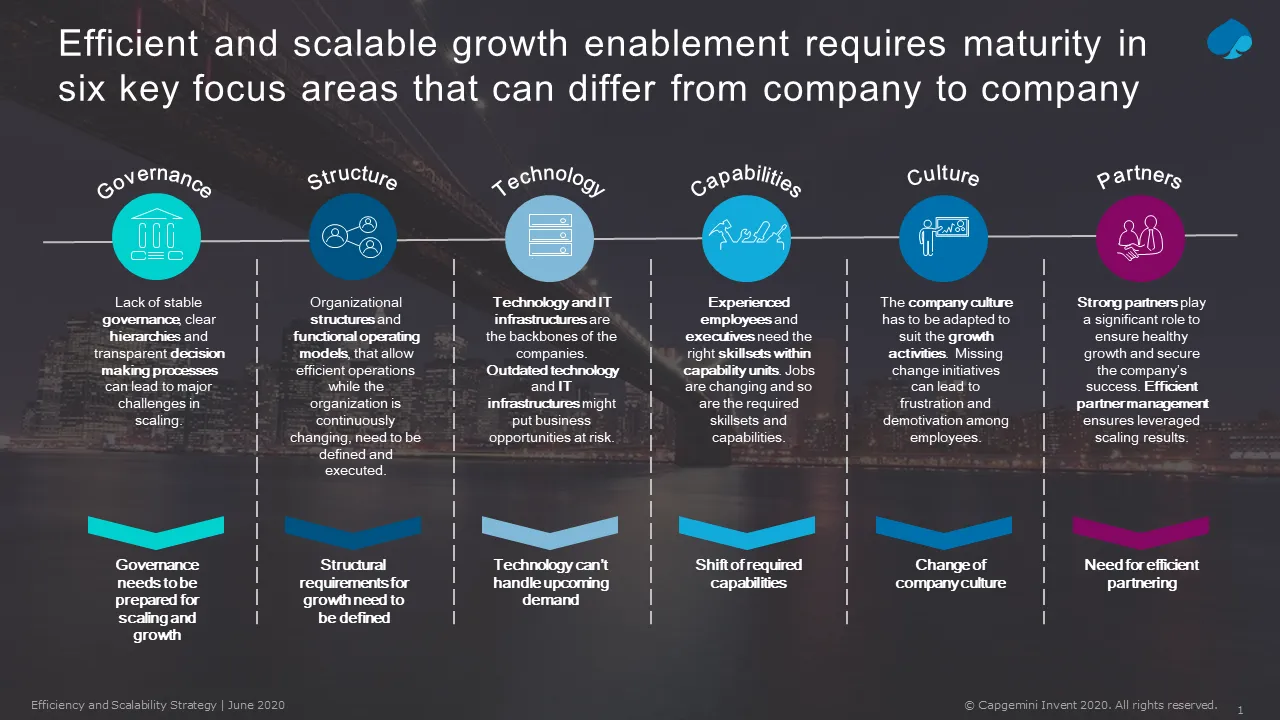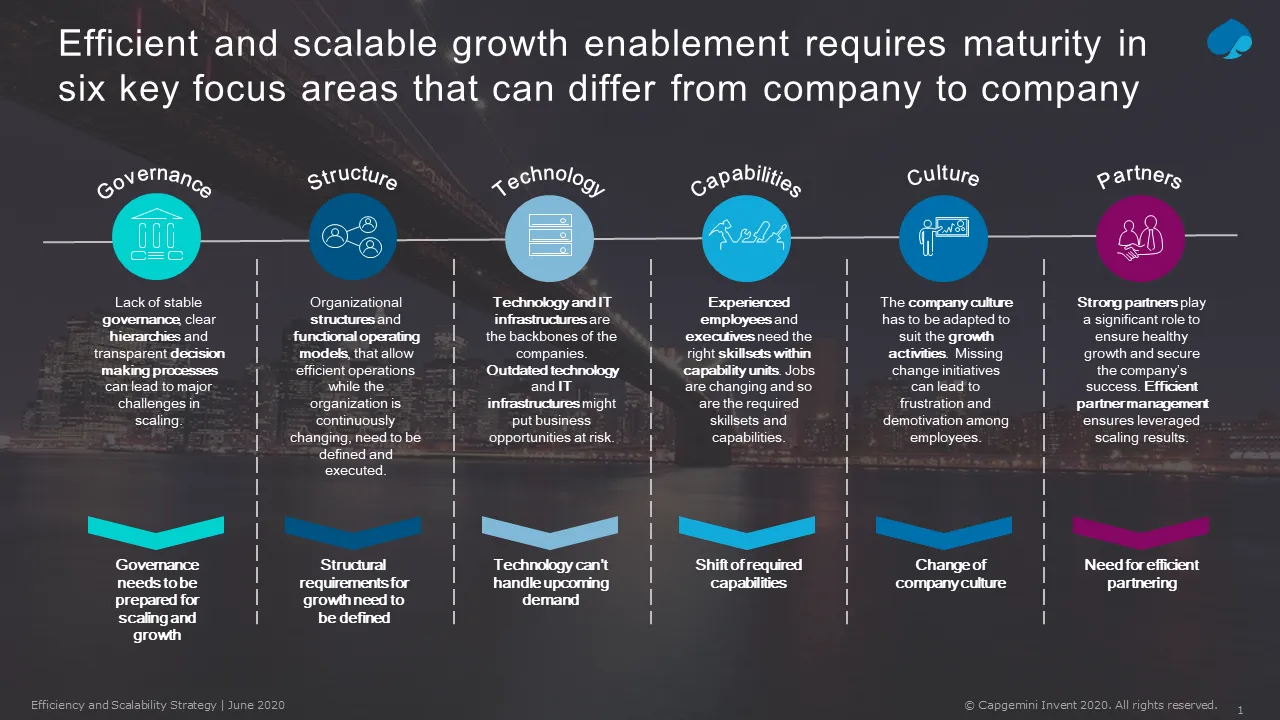The Scaling Hurdle PART 2
Blog: Capgemini CTO Blog
As described in our previous article, many OEMs and Captives have acquired or built up a growing number of mature start-ups in order to keep up with the innovative pace of competition from both industry incumbents and new entrants. While OEMs and Captives are able to quickly react to key innovative trends such as growing vehicle connectivity, increasing demand for autonomous driving, shifting requirements towards mobility models, and electrification, they often fail to leverage their existing start-up portfolio.
Additionally, the COVID-19 crisis has had massive and yet unforeseeable impacts that force OEMs and Captives to not only focus on future trends, but also to gain efficiencies in existing operations to recover from dropping sales. Therefore, in the following blog post we will examine the corresponding challenges OEMs and Captives face when scaling the start-ups in their portfolio and assess appropriate measures.
What are typical challenges companies face when scaling their start-up portfolio?
OEMs and Captives must retain the innovative mindset and capabilities of the start-ups in their portfolio. Furthermore, the start-ups’ products and services need to generate enough value for the Captives and OEM to benefit from the partnership in the long term. However, significant differences in structure, size, pace of innovation, and organizational maturity can lead to inefficiencies in the collaboration and thus, it comes to impairments in scaling up the value and innovative strength of the start-up portfolio.
The pressure to adapt to the requirements of the bigger company they belong to became very high due to COVID-19 as OEMs and Captives have been under high pressure and forced to gain efficiencies in order to recover from the economic and societal shock.
Typically, mature start-ups of OEMs and Captives encounter challenges in following areas:
-
Immature governance
Start-ups are known for flat hierarchies, very broad-scaled jobs, short decision-making processes, and a high willingness to take risks. However, in order to efficiently scale a company to a larger size, a stable governance, clear hierarchies, and transparent decision-making processes need to be in place.
-
Lack of clear company structure
Clear organizational structures and a successful operating model, which allow for efficient operations while the organization is changing, are a prerequisite for efficient scaling. Start-ups that have grown very quickly often have incomprehensible structures, that have evolved over time. Furthermore, well-established and scalable methodologies (e.g., in project and portfolio management) are often missing and lead to inefficiencies.
-
Overloaded technology and IT infrastructure
Technology and IT infrastructures are the backbones of the companies. As smaller companies are growing, they often push the boundaries of their IT-infrastructure. However, a solid and scalable IT is prerequisite to fulfill growing demands.
-
Shift of necessary capabilities
Certain skills and capabilities are crucial not only for a business to survive, but also for it to grow. As the company is becoming more mature, jobs often change from very broad-scaled jobs to more specialized ones. This change can also bring a shift in needed skillsets and capabilities. Knowing the capabilities, a company’s needs and getting the right people on board is a challenging task for smaller companies.
-
Changing company culture
The company culture must be adapted to suit the growth activities. Integrating continuous change management into scaling initiatives must be ensured in order to avoid frustration and demotivation.
-
Need for efficient partnering
Strong partners play a significant role to ensure healthy growth and to secure the company’s success. Efficient partner management ensures leveraged scaling results.
All these factors can lead to difficulties for both start-ups and related OEMs and Captives. However, there are various indicators that can be used to assess the right time to scale in order to avoid these challenges to become too severe.

Which indicators can be used to determine appropriate measures for scaling?
As elaborated in our previous article, scaling a business means that output is growing at a larger rate than input. In simple words, scaling means creating a foundation that enables the company to serve more customers, expand the product portfolio or improve processes so that revenue is growing at a larger rate than costs. In a way it means that a company is becoming more efficient in doing business.
Looking at mature start-ups of OEMs and Captives, it is not possible to determine the ideal time for optimization measures in relation to a specific point in time (e.g. after two years), but there are indicators and situations that can be taken as starting signals for scaling up business operations:
- Decreasing profitability: If processes and operations are not standardized at a certain level, costs tend to often grow at a larger rate than revenues. Standardizing processes and operations is one of the first steps to scale a business. It makes results more transparent and processes more efficient.
- Wrong prioritization of measures: Unclear portfolio management and a lack of prioritization rules for (strategic) initiatives are often indicators for scaling needs. When it becomes visible that initiatives are prioritized in a wrong way, a clear and transparent portfolio steering as part of a scaling strategy might be of help.
- Overloaded management: Due to flat hierarchies the management is overwhelmed and struggling with the number of employees they have to lead.
- Unclear targets: The demanded targets from the parent company seem unreachable and the roadmap to get there is unclear.
- Insufficient scaling of technology: The (information) technology used in the company is already outdated or is insufficient for a mid to large size company and therefore cannot handle increasing amount of transactions or customers.
- Deliverables are delayed due to lack of capacity: The organization is not able to do everything by itself anymore but is not yet seeking for external support. The organization needs suitable partners or additional resources that provide additional capacities.
- A crisis (like COVID-19) hits the business: The sales is dropping due to decreasing demand for the products and services.
Determining the right time for efficient scaling is not a simple task.
Continuous and careful monitoring is crucial to determine the right time to scale. A clear view into the future is key for the targeted implementation of scaling measures.
This article is co-authored by Anthony Gauchier, Justina Löwen and Evelyn Gabrysch.
This article is part of our blog series “The scaling hurdle” In the next article, we discuss the key success factors for efficient scaling, introduce our Capgemini Invent four-step approach to scale mature start-ups, and provide some insights about our sales recovery approach in times of economic crisis.
